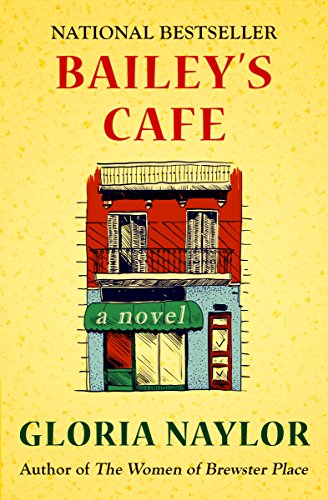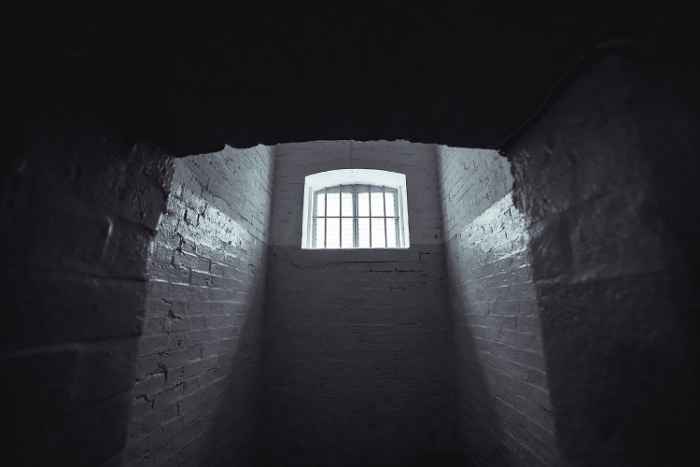Bailey’s Cafe: How Trauma Shapes Space

Traumatic events impact everyone differently, and in literature, trauma is often rooted in a character’s past and is slowly revealed to its readers by how it influences a character’s decisions. But what if trauma altered not just the characters, but their setting as well?
This notion is demonstrated in Bailey’s Cafe, a 1992 novel by Gloria Naylor. In this novel, black characters in pre-Civil Rights America converge at the fictional Bailey’s Cafe, a space that acts as a meeting place, home, workplace, and quiet corner for the weary to rest — changing to conform to the needs of each character’s memories. Traumatic events like war, abuse, death, and poverty erupt unexpectedly, altering the very time and place within which the characters interact. The evolving physical setting lends tangibility to the memories of these survivors, and reminds readers that memories are not stagnant things of the past–but that trauma may be lived and relived endlessly.
Trauma: Breaking Time & Space
Readers familiar with the symptoms of post-traumatic stress disorder (PTSD) may recognize its fingerprints on the characters of Bailey’s Cafe. Cathy Caruth, author and professor at Cornell University, contends that “trauma” is caused by a break in the body’s experience of time and space, such that the trauma is relived repeatedly, often manifesting as flashbacks and post-traumatic stress. When something in an individual’s present space triggers this cycle, the past erupts into the present. This notion is demonstrated in Bailey’s Cafe. The break in time and space that occurs during the reliving of trauma transforms the very space of the setting: Bailey’s Café, which is a cafe constructed of intersecting memories. These memories include the horrors of World War II, prostitution, ostracism, mutilation, and physical and emotional violence. The trauma endured by all the customers creates the collective need for a space like the café, but individual customers metaphysically transform the space according to their needs. Traumatic events directly create or reshape the spaces in the cafe. Conversely, spaces can directly influence how this trauma is relived and repeated, or healed. Therefore, trauma may embed itself into the geographical space of places as well as the physical characteristics of its survivors, and these individual memories converge in the café in order to celebrate survival.
 The Substance Abuse and Mental Health Services Administration (SAMHSA) defines trauma as something that can be triggered by a variety of events or contexts, with effects that can range from physical to emotional.
The Substance Abuse and Mental Health Services Administration (SAMHSA) defines trauma as something that can be triggered by a variety of events or contexts, with effects that can range from physical to emotional.
“Individual trauma results from an event, series of events, or set of circumstances experienced by an individual as physically or emotionally harmful or life-threatening with lasting adverse effects on the individual’s functioning and mental, physical, social, emotional, or spiritual well-being.”
In Bailey’s Cafe, Naylor specifically blurs the line between individual and collective trauma, showing how they can inform each other. In the first section of the book, Naylor uses italics to indicate where the character Bailey breaks from the current narrative to retell the collective horror of World War II. According to Caruth, “traumatic disorders reflect the direct imposition on the mind of the unavoidable reality of horrific events, the taking-over — psychically and neuro-biologically — of the mind by an event that it cannot control” (24). Throughout his memories, Bailey references Pearl Harbor, Guam, New Guinea, the Philippines, and Japan — suggesting an endless violence that Bailey himself certainly could not have experienced all himself. As it continues, it becomes apparent that the trauma he walks away with is more of a collective trauma that everyone experiences in wartime. He frequently refers to himself as a soldier, “I’m a soldier. I follow orders. But I beat them and they don’t lie down” (24), yet Naylor implies earlier in the text that he was a navy cook: “I could either learn to bake bread and peel potatoes or spend the summer of ‘42 in jail” (22). This means that the memories he describes were not just his, but every other war survivor who came back.
His moment of isolation upon returning to San Francisco, and considering his own suicide, was representative of many other men returning home and being unable to fathom their survival. Nadine’s act of reaching out through his mental “fog” is significant for this reason; it implies that the space subsequently created by him and Nadine, Bailey’s Cafe, is a getaway for all these other survivors who cannot reconcile the peacefulness of civilian living with their memories of destruction. Nadine somehow breaks into the psychological “taking-over” of his mind, and in doing so, changes the space he occupies.
Creating “Safe” Spaces

Naylor suggests that trauma forces individuals out of the comfort of previous safe spaces and forces them to either adapt to or recreate new space, often hinging upon the trauma experienced. Sadie’s trauma necessitates that she transforms the elements of the Cafe around her. It is well known among the Cafe’s patrons that she is a prostitute, yet Bailey describes the grace and pride with which she drinks her tea and occupies a small space of the Cafe. Her sense of pride is imbued in the elements around her in the Cafe, literally transforming them with her touch; a cracked mug becomes fine china and her fine-boned hand suggests a level of status or class contradictory to her profession. But just as her trauma allows her to gently manipulate her surroundings, it still controls her future; when the past comes bubbling up into her present, it prevents her from removing herself from those memories.
Sadie’s trauma is partly attributed to losing her home and returning to prostitution, which her mother forced her into when she was thirteen. As a result, when Iceman Jones — a man who delivers ice blocks and nurtures feelings for her — proposes, she is incapable of doing anything beyond living it out in her imagination. Her past memories of her home haunt her interaction with Iceman Jones. As they prepare to dance, creating a back step upon which to dance, she imagines what it would be like to make a new life with him:
Old girl, I’m gonna tell you, what you see is what you’ll get. I’m pushing sixty, fighting arthritis, but my pension will take care of two. He carved the chicken; they both liked wings, so he winked and told her it was a good thing God made ‘em in pairs. (Naylor 77)

According to Caruth, it is the “waking into consciousness that, peculiarly, is identified with the reliving of trauma,” (25) and as such, waking from this memory forces her to realize that she cannot accept him. Her home was taken away from her, but she relives its space as though it is a real possibility, paralleling the grace and class which Bailey witnesses in the Cafe. But the lasting memories of being widowed and homeless still press her to refuse the Iceman, as she feels she is incapable of living out that fantasy.
The need for trauma to be lived-out further manifests in Eve’s garden at the Cafe. Each flower in Eve’s garden is chosen by each of the women who chooses to take up residence at her “brothel”, a place named with a sexual connotation even if they choose not to accept male visitors. Eve, who was kicked out of her home by her grandfather for her curiosity about her sexuality and body, creates a space by Bailey’s Cafe specifically for nurturing women-aligned people that experience abuse. Contrasting the great violence these women have experienced with a blossoming flower, Naylor implies that one’s relationship with their trauma grows and evolves with them; only a token of regrowth can be used to gain access to their hearts and bodies. Moreover, Eve acts as the gatekeeper in a sense by deciding which women may stay at her residence by judging their stories. It is unclear whether it is the experiences themselves that Eve judges, or the way in which they affect these women; either way, Eve’s residence constantly shifts in tone and physical qualities with the addition of each.
Safe Spaces for Healing Trauma
The stories of “Miss Maple”, Esther, and “Peaches” seem to imply that Eve’s garden is a healing one. Names and nicknames flow interchangeably in Eve’s space; just as space changes, identity influences and is influenced by the healing nature of Eve’s space. Therefore some women go just by nicknames that the inhabitants find suitable. Stanley Beckwourth Booker T. Washington Carver, referred to as Miss Maple, has, by far, the most interesting relationship with Eve. Miss Maple and Eve both underwent long, tortuous journeys from their home: Eve, because she was outcast by her grandfather for her sexual desires, and Miss Maple, because he sought employment in a field that would always refuse him due to his race. Eve gets the sense that she can never wash off the “delta dust” that she accrued from both literally and figuratively being pushed into the dirt; and Miss Maple always wears womens’ dresses due to the rashes he developed in the heat when wearing his suits — a likely metaphor for trans, nonbinary, or non-gender conforming experiences. The parallels between the two are clear. Instead of using the space as a refuge, Miss Maple takes the same rooms that women seek for refuge and he cleans them while saving up money to start his own firm. His dresses become a chance to exercise control over how others perceive him, influenced by the trauma of physical assault in his youth. Eve’s residence as his place of employment is another such exercise of control over his surrounding space, and it gives the sense that space and time can offer a break in the harsh treatment of the “real world” to allow an abused person to build their past into something hopeful.
Aside from Miss Maple, each of the characters that enter Eve’s has a room almost custom to their trauma. Eve’s brothel confronts their histories head-on as each of the rooms change according to the trauma its resident experienced. Esther, for example, was a victim of sexual abuse as a child, and as she grows up, she realizes how her own family sold her out to a child molester.

The dark basement room that Eve gives her is just the same as the cellar where she was summoned to by her abuser, and in doing so, Eve acknowledges that Esther’s trauma will affect her self-worth: “So they don’t see my face. And I never see theirs. But I do like the way the white roses show up in the dark. I can see them clearly, very clearly, as they wither and die”. (Naylor 99) Her purity and innocence as child being lost, her callers bring her flowers in the dark, as the darkness that inhabits her mind is reflected in the room around her.
Mary “Peaches” slices open her own face in self-loathing, blaming herself for her sexual urges and how the world sees her beauty. Overcome with rage, frustration, and shame, Peaches came to Bailey’s Cafe after she ran away from home, self-mutilated. While it appears as though she never intends to seek plastic surgery, Eve tells Peaches’ father, who comes begging to take Peaches home, to “Go home, my friend. I’ll return your daughter to you whole” (114). Clearly, the scar will never heal, and increasingly, Peaches’ suitors cease their visits. But the scarification produces the intended result, and as she loses callers, the purpose of her stay at Eve’s seems to change. The physical manifestation of that trauma will never disappear from her face, but her room at the “brothel” encourages her healing process.
Jesse Bell, a drug addict, addresses the tendency of trauma to frequently reemerge, thus producing destructive results in the consciousness and in the space it controls. Jesse comes to Eve’s only to discover that Eve has customized syringes and needles for her drug use. The room’s purpose and elements takes shape around Jesse’s story, and Eve uses it to convince Jesse that the struggle is never over, as the memory of the heroin controls her daily surroundings. The memory of drugs creates this cycle of dosing and purging, just as trauma reemerges and dissipates in the consciousness: “For consciousness then the act of survival, as the experience of trauma, is the repeated confrontation with the necessity and impossibility of grasping the threat to one’s own life.” (Caruth 25) Eve forces Jesse to confront the threat of death over and over, and the space of her room conforms to enforce this, shrinking and growing, with an endless supply of her drugs at hand. To heal from the addiction, the brothel wants her to confront it: whether Jesse will be able to is left unclear.
Is Some Trauma Beyond Healing?

However, Naylor implies through one character’s fate that some trauma is irreconcilable, as there is no space that can support such an intense memory of violence. Mariam, a pregnant fourteen year old with a mental disability, brings something to the Cafe and to Eve’s which neither is accommodated for: a new life. When it does arrive, the baby is born in an ephemeral, in-between space created by Eve, because it has not had the same experiences as these women to warrant it having a room in the brothel. As Mariam dies in childbirth, she creates a space full of water: “And the void out back produced exactly what her childlike mind called up: endless water” (228). Even in death, Mariam is given the agency to change the space out back of Bailey’s Cafe to accommodate her trauma with something she found comforting.
The spatial manifestation of trauma varies in the Cafe but, in each case, survival was evident. Mariam couldn’t recover from the trauma of childbirth and death, therefore there was no space for her trauma at the Cafe except for a fleeting pool of water. For Caruth, there cannot be a discussion about trauma without acknowledging that it surfaces from the threat to one’s life; since Mariam died in childbirth, she does not have to relive her suffering. The cycle of abuse comes to a halt and something beautiful — new life — comes from it.
In this way, Naylor brings the book to a bittersweet conclusion — that the past reemerges even in unfamiliar spaces, making itself at home in elements of the physical and psychological space surrounding the survivor. The destructive force of trauma is reinforced by the stories of Peaches, Jesse, and Esther, but the spaces it is contained to cannot interfere with birth and growth. Perhaps this is the symbolism of Eve’s perennial garden: there is a place for growth and beauty even in the middle of winter.
Works Cited
Caruth, Cathy. “Violence and Time: Traumatic Survivals.” Assemblage (1993): 25-6. Print.
Naylor, Gloria. Bailey’s Cafe. New York: Vintage Contemporaries, 1992. Print.
“Trauma and Violence.” SAMHSA, 14 Jan. 2019, www.samhsa.gov/trauma-violence.
What do you think? Leave a comment.











The character of Miss Maple is such a great inspiration.
Miss Maple’s story stays in my mind as I teach math in high poverty urban schools. I love math because it is objective. It also resonates with me because of the absurdity of racism.
Gloria Naylor is one of my favorite authors. My favourites are “Mama Day” and “The Women of Brewster Place”.
Really interesting. It’s sort of an in between place, not quite of this world, yet not an escape either. What’s amazing in this is that this framework really works.
Oh thank you for much for covering this book, which was my close companion back in 1997. The place where travelers go as an escape, at the intersection of very real worlds.
That summer, I was living in a tiny town in Jordan, terribly ill and wishing for home for half the summer. The novel is so rich that it provides that escape-the perfect book at the perfect time. It’s magical realism done in the best possible way, and, none of them sci-fi.
That’s exactly what I love about this novel–it’s desire to by surreal, or even hyperreal, without falling into the sci-fi genre. It’s both the perfect escape but also an eerie magnification of everyday life. I never get tired of reading it.
Well, you already know what I’m going to say, so I’ll cut to the chase. Great article, a fascinating read and I was delighted to help in the editorial stage. As I mentioned to you privately, you’ve given me a new book to seek out and enjoy. Thanks. 🙂
Thank you!
It reminds me that each person has a certain comfort zone and why he/she chooses to be there may be based on common sense or be as trivial even to the person itself.
I like how the novel is an escape as it brings you to a world unknown and never imagined.
Some chapters seemed very disjointed to me and left me feeling a bit lost. And some of the stories, of the characters, were hard to read because it was upsetting and plain heartbreaking.
This was a lot like The Women of Brewster Place: sad stories about women with terrible lives.
I found the mysticism aspect of the book to be lacking. I didn’t much care for the idea of the back room at Bailey’s.
I also felt that Mariam’s story (the most tragic in my opinion) could have had so much more detail and been the arc of the book that held the stories together, but Naylor treats her more like a throw-away character.
The concept of a cafe to go to when you’re in a state of limbo is very appealing.
I hope that I can find Bailey’s should I ever need it.
I read this a million years ago, but I remember liking it a lot.
This is a very interesting article, although I’m not familiar with this book. Interestingly, I remember reading somewhere that trying to avoid things reminiscent of a trauma is in itself a core symptom of PTSD, that must be fought against–a lot of PTSD treatments entail helping people confront their fears and triggers rather than run away from them. Is that something that comes up much in this book? The way you describe it it seems like it does: for instance, the one drug-addicted character who has to confront the needles and syringes from their past. Or am I misunderstanding?
No, that’s exactly it! Jesse is forced to confront her drug use in a never-ending cycle that mimics the cycle of addiction and recovery. However, I would argue that it’s less like desensitization training for PTSD, and more like a larger metaphor for the unending struggle of minority groups and drug use. I didn’t get the sense that Jesse as a character would ever beat her drug use or resolve the trauma associated with it. Every character in this book feels representative of a larger issue intersecting with black identity in the U.S. (except for Mariam) and therefore a resolution to their issue is never presented, because these issues will never be fully resolved. But I would really encourage you to give the book a shot, and let me know what you think. It’s a fascinating read and based on the topics you have written on, I think you might enjoy the psychological elements!
A good essay. I recommended this essay to my daughter who is a therapist since she has some patients who struggle with trauma.
Baileys Cafe is a wonderful, contemporary companion to Chaucer’s Canterbury Tales.
The novel is structured in the form of a jazz performance, and I swear I could feel the beat!!
I’m confused about the back door of Bailey’s Cafe. Many people speak of this book as being layers, but I cannot understand how others can see another’s vision.
I love the way Naylor intertwines the different stories, transitioning from one to the next without it feeling jumpy.
One of my fav novels. The ending was so powerful in that all the characters had in common a safe place in the cafe and that the author did not try to make the audience feel better.
I LOVE magical realism like Bailey’s Cafe. Thanks for the great analysis.
Writers often aspire to this level and usually land far short of the goal.
Really tackles some pertinent issues of gender and race. However, I didn’t like it as well as Mama Day.
Wish I had read this before Mama Day! It would have helped me understand it better!
It sounds like a haunting sort of story.
Fascinating, depressing and beautifully written.
I love the way the cafe in this story brings together characters with very different lives who share their stories. Fiction writers: learn.
I loved the premise but the stories were heartbreaking.
It actually has some interesting takes on the subconscious and psychology of people who have problems.
I read this for a book club and this is not the kind of book that I would normally read. I know there will be a good discussion.
The characters remind me of family members and friends from my past.
I especially enjoyed the historical content.
Nice
This is a very thought-provoking and thorough essay! I really like your theory on creating safe spaces and healing trauma. Also the correlation you draw between Eve and Miss Maple’s stories is very interesting. You’ve put a lot of consideration into this article, and it is very well written. Thank you for sharing it with us!
Incredible-sounding plot. I appreciated how you brought up trauma’s affect on the physical body. It boggles my mind that so many people still do not understand, or even acknowledge, that trauma, like physical illness, has a physical root that can, at least in most cases, be understood and at least somewhat healed. Even if, as you suggested, some trauma is beyond healing, trauma sufferers are crying out for compassion, and many people outside trauma still fail to provide it.
Beautiful discussion of what appears to be a complex but important text, this was well handled and honoured the work it discussed. Thanks for sharing.
I’m drawn to the temporal element you’ve highlighted as well (in the form of repetition). There’s almost a sense that a spatial emergence triggers a temporal regress. Very provocative!
This is by far, one of the most interesting read on this website for me! Amazing work!
This novel sounds really fascinating and exactly what I need right now! I’m in need of new books to read during isolation and this one is on the list, fantastic stuff 🙂